Cholesterol sensor ORP1L contacts the ER protein VAP to control Rab7-RILP-p150 Glued and late endosome positioning
- PMID: 19564404
- PMCID: PMC2712958
- DOI: 10.1083/jcb.200811005
Cholesterol sensor ORP1L contacts the ER protein VAP to control Rab7-RILP-p150 Glued and late endosome positioning
Abstract
Late endosomes (LEs) have characteristic intracellular distributions determined by their interactions with various motor proteins. Motor proteins associated to the dynactin subunit p150(Glued) bind to LEs via the Rab7 effector Rab7-interacting lysosomal protein (RILP) in association with the oxysterol-binding protein ORP1L. We found that cholesterol levels in LEs are sensed by ORP1L and are lower in peripheral vesicles. Under low cholesterol conditions, ORP1L conformation induces the formation of endoplasmic reticulum (ER)-LE membrane contact sites. At these sites, the ER protein VAP (VAMP [vesicle-associated membrane protein]-associated ER protein) can interact in trans with the Rab7-RILP complex to remove p150(Glued) and associated motors. LEs then move to the microtubule plus end. Under high cholesterol conditions, as in Niemann-Pick type C disease, this process is prevented, and LEs accumulate at the microtubule minus end as the result of dynein motor activity. These data explain how the ER and cholesterol control the association of LEs with motor proteins and their positioning in cells.
Figures
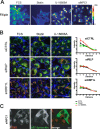
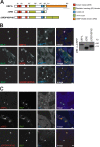

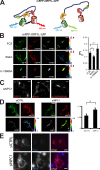

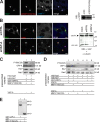

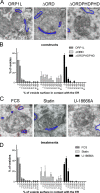

Similar articles
-
Activation of endosomal dynein motors by stepwise assembly of Rab7-RILP-p150Glued, ORP1L, and the receptor betalll spectrin.J Cell Biol. 2007 Feb 12;176(4):459-71. doi: 10.1083/jcb.200606077. Epub 2007 Feb 5. J Cell Biol. 2007. PMID: 17283181 Free PMC article.
-
Late endosomal transport and tethering are coupled processes controlled by RILP and the cholesterol sensor ORP1L.J Cell Sci. 2013 Aug 1;126(Pt 15):3462-74. doi: 10.1242/jcs.129270. Epub 2013 May 31. J Cell Sci. 2013. PMID: 23729732
-
RILP Induces Cholesterol Accumulation in Lysosomes by Inhibiting Endoplasmic Reticulum-Endolysosome Interactions.Cells. 2024 Aug 6;13(16):1313. doi: 10.3390/cells13161313. Cells. 2024. PMID: 39195203 Free PMC article.
-
ER-endosome contact sites in endosome positioning and protrusion outgrowth.Biochem Soc Trans. 2016 Apr 15;44(2):441-6. doi: 10.1042/BST20150246. Biochem Soc Trans. 2016. PMID: 27068952 Review.
-
Touché! STARD3 and STARD3NL tether the ER to endosomes.Biochem Soc Trans. 2016 Apr 15;44(2):493-8. doi: 10.1042/BST20150269. Biochem Soc Trans. 2016. PMID: 27068960 Review.
Cited by
-
Quantitative imaging of membrane contact sites for sterol transfer between endo-lysosomes and mitochondria in living cells.Sci Rep. 2021 Apr 26;11(1):8927. doi: 10.1038/s41598-021-87876-7. Sci Rep. 2021. PMID: 33903617 Free PMC article.
-
PtdIns(4)P regulates retromer-motor interaction to facilitate dynein-cargo dissociation at the trans-Golgi network.Nat Cell Biol. 2013 Apr;15(4):417-29. doi: 10.1038/ncb2710. Epub 2013 Mar 24. Nat Cell Biol. 2013. PMID: 23524952
-
Niemann-Pick Disease Type C (NPDC) by Mutation of NPC1 and NPC2: Aberrant Lysosomal Cholesterol Trafficking and Oxidative Stress.Antioxidants (Basel). 2023 Nov 21;12(12):2021. doi: 10.3390/antiox12122021. Antioxidants (Basel). 2023. PMID: 38136141 Free PMC article. Review.
-
Neuronal ceroid lipofuscinosis protein CLN3 interacts with motor proteins and modifies location of late endosomal compartments.Cell Mol Life Sci. 2012 Jun;69(12):2075-89. doi: 10.1007/s00018-011-0913-1. Epub 2012 Jan 20. Cell Mol Life Sci. 2012. PMID: 22261744 Free PMC article.
-
Lysosomal positioning diseases: beyond substrate storage.Open Biol. 2022 Oct;12(10):220155. doi: 10.1098/rsob.220155. Epub 2022 Oct 26. Open Biol. 2022. PMID: 36285443 Free PMC article. Review.
References
-
- Bastiaens P.I., Squire A. 1999. Fluorescence lifetime imaging microscopy: spatial resolution of biochemical processes in the cell.Trends Cell Biol. 9:48–52 - PubMed
-
- Brown C.L., Maier K.C., Stauber T., Ginkel L.M., Wordeman L., Vernos I., Schroer T.A. 2005. Kinesin-2 is a motor for late endosomes and lysosomes.Traffic. 6:1114–1124 - PubMed
-
- Calafat J., Janssen H., Stahle-Backdahl M., Zuurbier A.E., Knol E.F., Egesten A. 1997. Human monocytes and neutrophils store transforming growth factor-alpha in a subpopulation of cytoplasmic granules.Blood. 90:1255–1266 - PubMed
Publication types
MeSH terms
Substances
LinkOut - more resources
Full Text Sources
Other Literature Sources
Medical
Molecular Biology Databases

